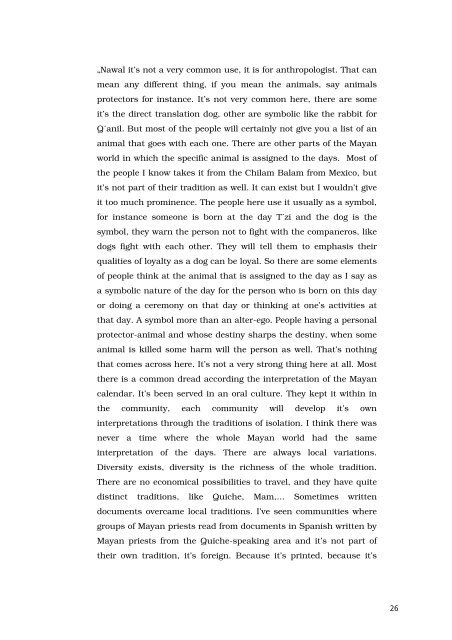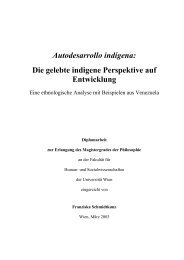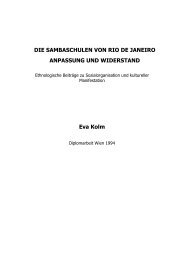Maya Spiritualität und Globalisierung - Lateinamerika-Studien Online
Maya Spiritualität und Globalisierung - Lateinamerika-Studien Online
Maya Spiritualität und Globalisierung - Lateinamerika-Studien Online
Erfolgreiche ePaper selbst erstellen
Machen Sie aus Ihren PDF Publikationen ein blätterbares Flipbook mit unserer einzigartigen Google optimierten e-Paper Software.
„Nawal it’s not a very common use, it is for anthropologist. That can<br />
mean any different thing, if you mean the animals, say animals<br />
protectors for instance. It’s not very common here, there are some<br />
it’s the direct translation dog, other are symbolic like the rabbit for<br />
Q´anil. But most of the people will certainly not give you a list of an<br />
animal that goes with each one. There are other parts of the <strong>Maya</strong>n<br />
world in which the specific animal is assigned to the days. Most of<br />
the people I know takes it from the Chilam Balam from Mexico, but<br />
it’s not part of their tradition as well. It can exist but I wouldn’t give<br />
it too much prominence. The people here use it usually as a symbol,<br />
for instance someone is born at the day T´zi and the dog is the<br />
symbol, they warn the person not to fight with the companeros, like<br />
dogs fight with each other. They will tell them to emphasis their<br />
qualities of loyalty as a dog can be loyal. So there are some elements<br />
of people think at the animal that is assigned to the day as I say as<br />
a symbolic nature of the day for the person who is born on this day<br />
or doing a ceremony on that day or thinking at one’s activities at<br />
that day. A symbol more than an alter-ego. People having a personal<br />
protector-animal and whose destiny sharps the destiny, when some<br />
animal is killed some harm will the person as well. That’s nothing<br />
that comes across here. It’s not a very strong thing here at all. Most<br />
there is a common dread according the interpretation of the <strong>Maya</strong>n<br />
calendar. It’s been served in an oral culture. They kept it within in<br />
the community, each community will develop it’s own<br />
interpretations through the traditions of isolation. I think there was<br />
never a time where the whole <strong>Maya</strong>n world had the same<br />
interpretation of the days. There are always local variations.<br />
Diversity exists, diversity is the richness of the whole tradition.<br />
There are no economical possibilities to travel, and they have quite<br />
distinct traditions, like Quiche, Mam,... Sometimes written<br />
documents overcame local traditions. I’ve seen communities where<br />
groups of <strong>Maya</strong>n priests read from documents in Spanish written by<br />
<strong>Maya</strong>n priests from the Quiche-speaking area and it’s not part of<br />
their own tradition, it’s foreign. Because it’s printed, because it’s<br />
26





